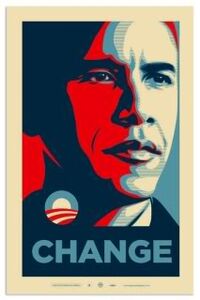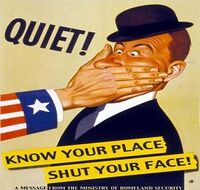Making Propaganda: Difference between revisions
>Hitlerlol Created page with '{| | __ToC__ | =Introduction= right|200px|thumb|STFU In large-scale raids, it is often necessary to reach out to broader audiences (e.g., 4chan ...' |
>Hitlerlol No edit summary |
||
| Line 90: | Line 90: | ||
* [[Forum Trolling]] | * [[Forum Trolling]] | ||
* [[PsyOps]] | * [[PsyOps]] | ||
[[category:Tutorials]] | |||
Revision as of 21:50, 24 August 2010
Medium

In the past, the medium of propaganda was limited solely to either word of mouth (as in dictatorial decree), posters, statues, or other physical objects. This began to change in a large way with the popular Fireside chats of former President Franklin D. Roosevelt. In these talks, FDR used a relatively new medium--the radio--in order to present a message to his constituents. Not merely for informational purposes, this also allowed him to connect with the voters in an unprecedented way. In the 1960 election, the advent of television dramatically impacted the outcome as Kennedy knew how to promote his image over the air in a way that appealed more to voters than a pale, skinny, scruffy, middle-aged man.
Of course, there is now the internet. With the advent of the internet, propaganda began to become more subtle, and also much more important. This was quite apparent with the online presence of Ron Paul, a political outsider who, all things considered, would be relatively unknown if not for internet supporters. The election of President Obama, moreover, is also largely due to the internet. Through mastery of social media, Obama managed to gain wide approval, having started late against a well established candidate. This all underlies the fact that the internet is the most important modern medium for propaganda, rivaled only by television.
The target
| Age | This is important because of the values that differ across generational divides. What convinces an 18 year old will not be as effective for an 80 year old. |
| Gender | An obvious one, the fact is that men and women view things differently. This becomes very apparent when trying to utilize humor (feminists won't find blonde jokes funny, for instance), or when using war porn or appealing to masculinity. |
| Religion | This one is simple top understand: If the target is Christian, paint the enemy as Muslims, Atheists, or any other opposing sect. If the target is Islam, paint the enemy as infidels. |
| Geography | Amerifags will have a much different outlook on, say, the Middle East, than will someone from South Korea. On the internet, this also means differentiating between targets on Facebook and on /b/. |
Why Knowing Your Target is Important
Propaganda is effective because its creators know who the target is. Communist propaganda is aimed at workers; Republican propaganda at angry, middle-aged white males. In the case of raids, the target should be profiled and pandered to. The most important factors are those which contribute most to one's social outlook (e.g., not hair color). Some general markers, and possible reasons for relevance, can be found in the table. Good propaganda should be specific enough to be effective with the target audience, but general enough to have sufficient appeal to make change.
Examples of Usage
It might help to look at the difference in propaganda used in, say, Project Chanology, in the mainstream media and on /b/.
- What we mean: "Help us raid Scientology"
- What we say to /b/: "Let's fuck with this tiny religion. They're small enough to be a doable target, but large enough to be a fat lulzcow. They have a history of overreacting to trolling, so this will be rich."
- What we say to MSM: "This cult is guilty of crimes against humanity; it has systematically censored opposition, has oppression policies against detractors, and evades taxes"
Content
In all of this, the most important aspect of propaganda has yet to be covered: the content. That is, the thing which is being transmitted via a given medium (e.g., television, radio, internet) to a target audience. The content of propaganda is that which persuades the target to come to the side of those who are creating it. The important aspects of propaganda content are the message and the aesthetic.
The Aesthetic
Tying it to the target and the medium, the aesthetic of propaganda is very important in convincing others of a viewpoint. It might be important to have a solid understanding of art theory and art history here, as some trends have been more successful than others over the course of history.
The Soviets

The soviets were experts at propaganda. Both at home and all over the world, they used subtle forms of propaganda in order to achieve certain goals in regards to foreign policy and domestic opinion. Their posters and statues, however, were remarkable in both effectiveness and in the precision with which they worked.
Soviet propaganda should be viewed in the school of artistic Constructivism. Constructivism, in a nutshell, was an artistic theory that valued the message of art, rather than the art-in-itself. This was followed by Socialist Realism, the official policy of the USSR which sued art to further or glorify Socialist goals or ideals.
In looking soviet posters, there are some themes that become apparent: they consisted of bold colors, generally geometric construction, and had a Romantic/Classical representation of man as embodied by the proletariat. Facial features were well-defined, and bodies chiseled, bringing to mind ideas of human perfection and possibility. These things together were meant to inspire hope and confidence in the masses, and to orient them towards social goals. Soviet statues were also highly Romantic and Classical, and might be described as a Socialized kind of Greek revivalism.

Modern examples of Soviet-style propaganda could be said to include the popular "Change" poster for Obama's 2008 election, which featured many of the hallmarks of Soviet Propaganda: it used bold colors (as part of a uniform, patriotic, nationalistic color scheme), geometric shapes, and an idealistic/Romantic representation of the leader (Obama) meant to inspire confidence towards a particular goal ("Change"). In this it was highly effective, spawning many derivative and spin-off works.
The Message
What the Goal Should Be
The proper mark of modern propaganda isn't that you spread it, it is that the target spreads it. If propaganda was only spread top-down, center-out, it would be incredibly inefficient as well as easily ignored. Rather, the goal (especially in the age of the internet) should be to get the target audience themselves to spread, and if possible improve upon, the propaganda. Increasingly, this means that you want to sell an identity--whether that means bundling it with fashion, focusing on a cult of personality, etc, the important thing is that the target buys into it.
Look at Fox News: they sell their target audience an identity--that of angry, patriotic, skeptical conservatives who defend their country domestically against internal threats. In the 2008 election, the Democratic party used Obama as the figurehead for an identity which represented, obviously "change", progress, equality, etc. In either case, the remarkable thing is that, once the image was created, the target took it and made it their own--after which the memetic image spread like wildfire via word-of-mouth.
Chanology

In Project Chanology, there was the image of Anonymous. As oxymoronic as it sounds (though, as written in 1984, the best propaganda doesn't need to make sense), there were some themes in regards to how the propaganda was spread. Aesthetic-wise, the posters generally used a bold color scheme of black, white, green, and red. While there wasn't particular focus on geometric shapes, the propaganda was usually rather simple and to-the-point, often including specific instructions within it. Moreover, this was coupled with an identity: by wearing a mask (fashion), you were able to join this collective consciousness (or so that propaganda went). Being a part of something larger than oneself has always been an attractive notion, and in this case the coupled aesthetic and targeted message were highly effective in mobilizing large numbers of people at the bidding of the propaganda-writers.
Appealing to Ego
In order to create the image, moreover, realize that you have to apply to people's ego. That is, make them feel important, and make them feel like their opinion factors in. This has manifested in "Town Hall" meetings, for instance, and also in the GOP asking for policy suggestions on the internet. Remember, it is less important to listen to them as to APPEAR to listen to them. Part of the way in which raids work on image boards is that everyone can contribute without fear of reprisal; because people feel like they can help out, and because they have bought into the identity, they can feed their ego with any resulting success. The result is that people get a sense of twisted pride which then feeds into the process over again.
Methodology
There are some specific techniques which, when applied, work wonders towards getting people to rally behind a certain goal. These are fairly well known, so this introduction will be brief and cover a single concept. Additional ideas can be found in the PsyOps article.
The Big Lie

This is simply the practice of creating a lie so large, complex, and essential, that people will assume it is true. Examples include the belief that Obama is a Muslim, for instance, which while unsubstantiated has regardless grown in popularity to the degree that the propaganda makers can orient the resulting anger towards specific socio-political goals. In raids, it may help to paint the opposition into a corner elaborate and ugly enough to smear them--regardless of whether it is true. "Glenn beck raped and murdered a girl in 1990" is one such big lie (or is it?) that has been used; another was painting Dahvie as a child rapist.
